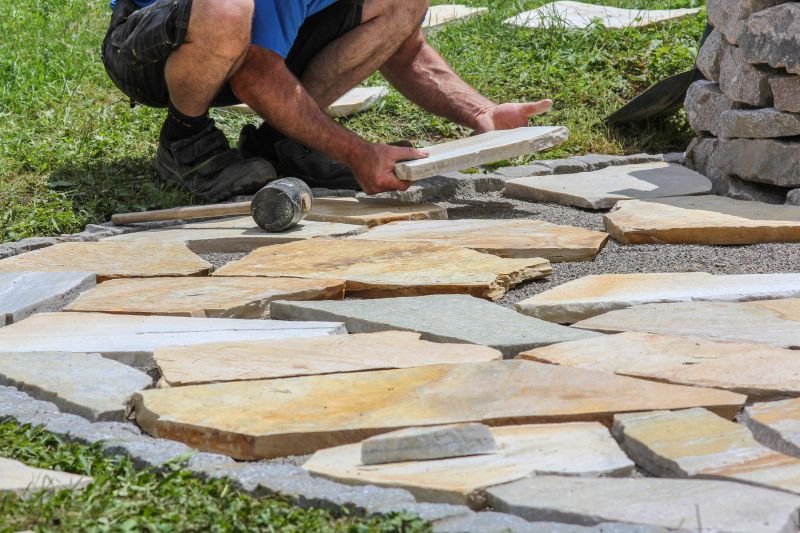Leading Options For Fixing Stone Pavement Damage
Find out which repair products professionals trust to fix cracks, chips, and other common issues in stone pavements.
 Stone pavements are valued for their durability and aesthetic appeal, but over time, they can develop cracks, uneven surfaces, or loose stones due to weathering, ground movement, or heavy traffic. Proper repair and maintenance are essential to preserve the integrity and appearance of these surfaces. A variety of products are available to address different repair needs, from filling cracks to stabilizing loose stones and restoring surface smoothness. Selecting the right materials can extend the lifespan of the pavement and reduce the need for costly replacements.
Stone pavements are valued for their durability and aesthetic appeal, but over time, they can develop cracks, uneven surfaces, or loose stones due to weathering, ground movement, or heavy traffic. Proper repair and maintenance are essential to preserve the integrity and appearance of these surfaces. A variety of products are available to address different repair needs, from filling cracks to stabilizing loose stones and restoring surface smoothness. Selecting the right materials can extend the lifespan of the pavement and reduce the need for costly replacements.
Top Overall Option
Multi-Purpose Stone Repair Compound
A versatile repair compound designed for filling cracks, stabilizing loose stones, and restoring uneven surfaces. It offers good adhesion, durability, and ease of application, making it suitable for various types of stone pavements and repair scenarios.
Types of Products For Stone Pavement Repairs
Crack Filler and Sealant
Products formulated to fill and seal cracks, preventing water ingress and further deterioration.
Mortar Mixes
Specialized mortar blends for setting loose stones and reconstructing damaged areas.
Paving Stabilizers
Materials that help stabilize and reinforce loose or shifting stones for long-term stability.
Surface Patching Compounds
Ready-to-use compounds for filling voids and leveling uneven surfaces.
Stone Adhesives
High-strength adhesives designed for bonding stones securely in place.
Sealants and Protective Coatings
Products that create a protective barrier against moisture, stains, and debris.
Grout and Joint Filler
Materials used to fill joints between stones for stability and aesthetic uniformity.
Polymer Resins
Flexible resins suitable for repairing cracks and reinforcing stone surfaces.
Concrete Patching Mixes
Heavy-duty mixes for significant repairs and surface reconstruction.
Epoxy Resins
Strong adhesives and repair agents for structural reinforcement.
Stone Cleaning Products
Solutions to clean and prepare stones before repair application.
Waterproofing Agents
Products that help prevent water penetration and damage.
Repointing Mortar
Special mortar for renewing the joints between stones.
Vibration and Compacting Tools
Equipment used to ensure proper settling and stability of repaired areas.
Color-Matching Compounds
Materials that help blend repairs seamlessly with existing stones.
Popular Choices
Widely used for sealing small to medium cracks and preventing water infiltration.
Commonly selected for resetting loose stones and patching damaged areas.
Popular for smoothing uneven surfaces and filling voids efficiently.
Trending for restoring the appearance and stability of stone joints.
Chosen for their flexibility and adhesion properties in various repair scenarios.
Convenient options for quick surface protection and sealing.
Popular for bonding stones securely in complex repairs.
Frequently used to extend the lifespan of repaired surfaces.
All-in-one solutions for small-scale repairs and touch-ups.
Commonly selected for renewing joint integrity.
Popular for ensuring proper compaction during repairs.
Favored for seamless blending with existing stones.
Often used before applying repair products to improve adhesion.
Chosen for their ability to accommodate ground movement and minor shifts.
Widely used for structural repairs and reinforcement.
Popular for long-term surface protection against stains and moisture.
When considering repairs for stone pavements, it is important to evaluate the extent of damage, the type of stones used, and the underlying base condition. Some repairs require simple patching compounds, while others might need more specialized solutions like mortar mixes or stabilization products. Using the appropriate repair products ensures that the repair blends seamlessly with the existing surface and maintains the overall aesthetic.
Maintenance products also include sealers and protective coatings that can help prevent future damage by creating a barrier against moisture and debris. For larger or more complex repairs, professional-grade materials may be necessary to ensure long-lasting results. Proper application techniques, curing times, and compatibility with existing materials are crucial factors to consider for successful repairs.
Overall, choosing the right products for stone pavement repair involves understanding the specific needs of your surface, the nature of the damage, and the desired longevity of the repair. By selecting suitable repair compounds, stabilizers, and protective coatings, property owners can effectively maintain the beauty and functionality of their stone pavements for years to come.
Key Buying Considerations
- Type and extent of damage to determine appropriate repair products.
- Compatibility of repair materials with existing stone types and mortar.
- Ease of application and required tools or equipment.
- Durability and longevity of the repair solution.
- Drying and curing times to plan repair schedules accordingly.
- Aesthetic considerations such as color matching and surface finish.
- Water resistance and suitability for outdoor or high-moisture environments.
- Flexibility of repair materials to accommodate ground movement.
- Cost and availability of repair products.
- Manufacturer instructions and recommended application techniques.
- Potential need for sealing or protective coatings post-repair.
- Environmental conditions during application, such as temperature and humidity.
- Availability of repair kits versus individual components.
- Storage stability and shelf life of repair compounds.
- Professional versus DIY repair options based on complexity.
